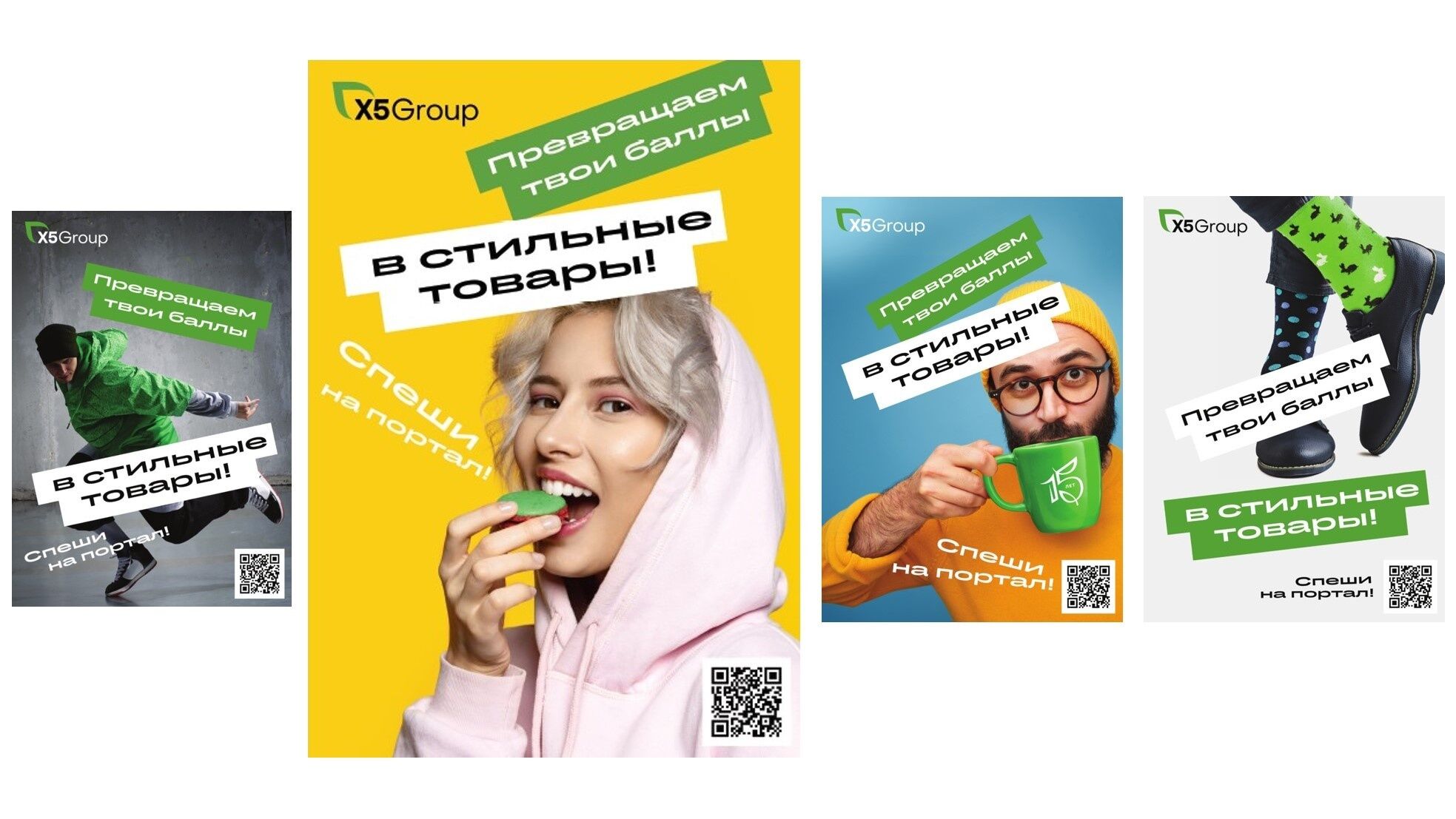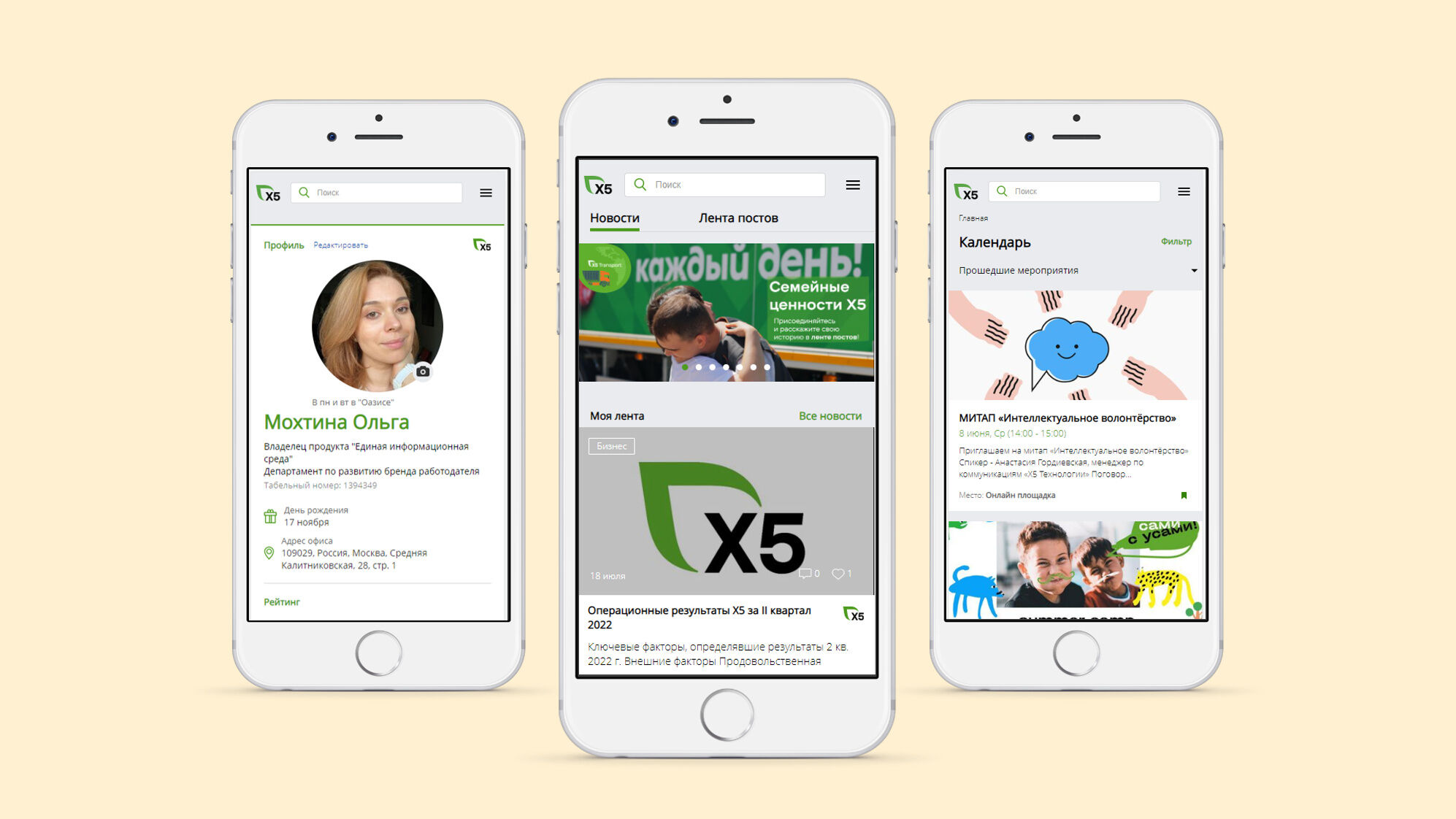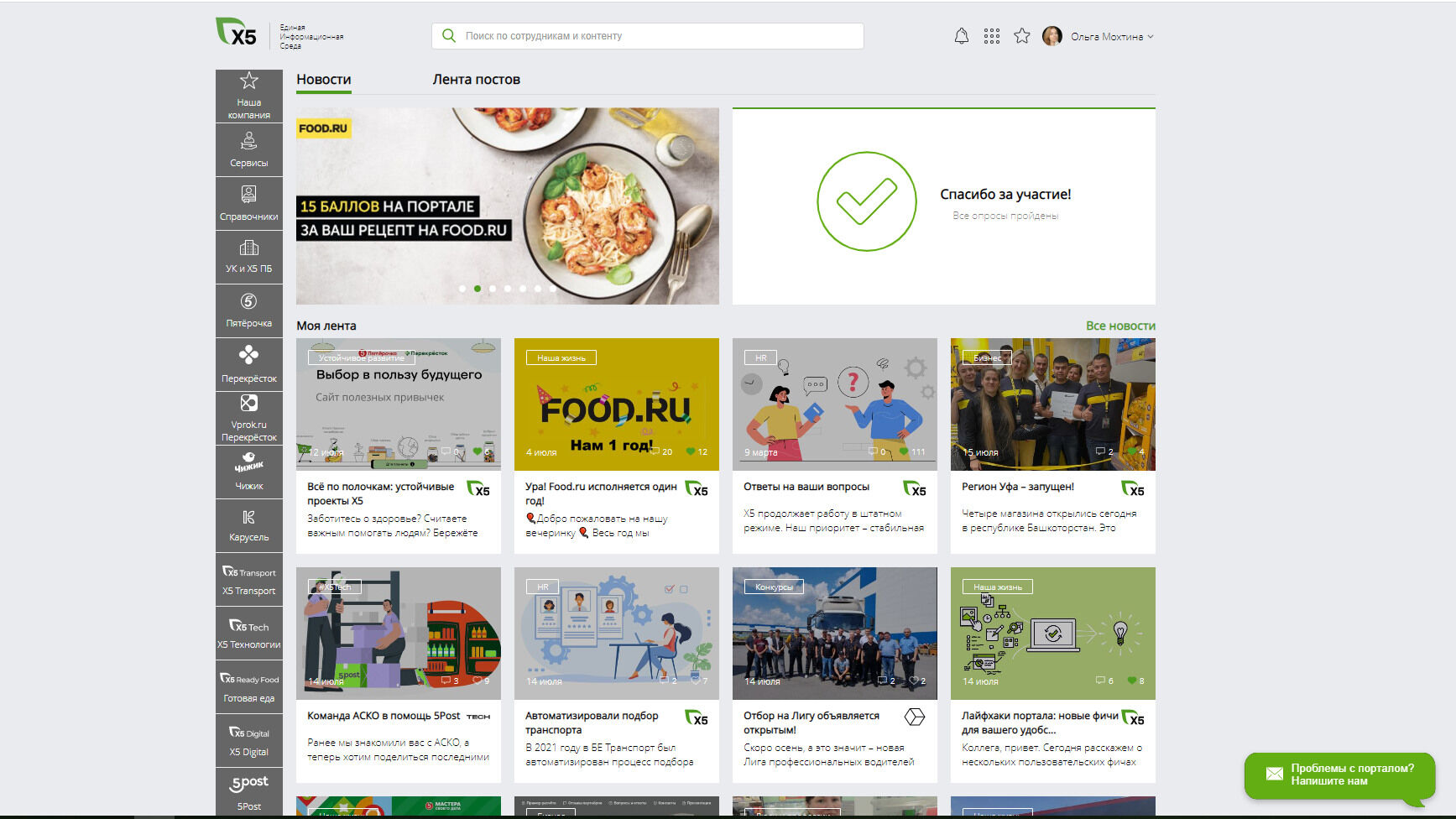Intranet renovation for 350,000 employees
The X5 Group intranet renovation project was a massive digital transformation that spanned multiple departments and directly impacted over 328,000 employees at the time. And I was a part of it.
This was a project of immense scale for the company and multiple teams, and I had the privilege of being part of it as a content and communications manager. Our goal was to build a unified, efficient, and modern intranet system that would not only serve our employees better but also enhance their daily work experiences and increase overall engagement. Now, before I dive into the specifics of the project, let me provide some background on X5 Group and why such a massive intranet renovation was necessary.
X5 Group is a leading Russian retail company, operating several grocery store chains, various digital and media platforms, delivery and logistics solutions, and a separate technology and innovation unit. Overall employee count is more than 370,000 people. The Group also the largest grocery retailer in terms of store count, with more than 20,000 stores across the country and a significant presence in Moscow, St. Petersburg, and other major cities.
One of the key challenges we faced as a company was the sheer diversity of our workforce. We have employees ranging from store clerks and cashiers to drivers, logistics personnel, and corporate managers.
With such a vast number of employees in different roles, communication had to be seamless. But, unfortunately, this was not the case with our existing intranet systems. The old intranet was outdated, slow, and unable to meet the needs of our growing and changing business.
The Challanges
Before we began the renovation, X5 Group had four separate intranet systems, all based on SharePoint 2013. These platforms operated independently, creating significant issues. Let me outline the main problems: The company’s outdated systems were not only slow but also built on technology that could no longer scale or adapt to its growing needs. With four independent platforms, there was no centralized strategy for content management or user access, leading to duplicated content, fragmented workflows, and inconsistent user experiences. Additionally, the portals had an old-fashioned design, limited functionality, and lacked mobile access—making it especially difficult for retail employees, who rarely had access to computers during work hours, to stay connected with corporate communications. For those managing the intranet, content creation was inefficient and time-consuming, often taking up to 30 minutes to create a simple page due to the absence of templates and standardized processes. This discouraged departments from maintaining their sections, further diminishing engagement. As a result, employees viewed the intranet as a burden rather than a valuable tool, lacking trust in its ability to provide essential information and resources. Our goal was to change that.
Vision
Our vision was to create a unified digital workplace that served all employees across X5 Group, whether they worked in an office, store, or logistics center. This platform needed to be user-friendly, mobile-accessible, and personalized to each employee’s role while also integrating business processes to enhance daily workflows. To achieve this, we focused on unifying all platforms into a single access point, ensuring a tailored experience for every user, and prioritizing mobile accessibility—critical for the 87% of employees without regular computer access. Additionally, we streamlined content management, making it faster and more efficient for editors to maintain and update information.
Planning and Reseach
The first step in renovating the intranet was a comprehensive audit to understand both technical limitations and employee needs across departments. We conducted over 100 interviews with stakeholders, analyzed employee surveys and web analytics, and reviewed internal reports to identify key business requirements. This research revealed that many store employees had never used the intranet due to accessibility issues and a lack of relevant content. Based on these insights, we focused on four priorities: enhancing speed and performance, creating a unified platform for all employees, ensuring an intuitive user experience, and prioritizing mobile accessibility as the primary access point.
Development Approach
With the planning phase complete, we moved into development, choosing to build the intranet in-house using Python, React, and TypeScript for greater flexibility and control. Adopting an agile methodology, we worked in two-week sprints, allowing us to iterate quickly based on user feedback. User testing played a crucial role throughout the process, ensuring the platform was intuitive and met employees' needs. For instance, we gathered feedback from store employees on the mobile interface and refined the design accordingly, making the intranet more accessible and user-friendly for the entire workforce.
Key Features
The new intranet, called the Unified Information Environment (UIE), introduced several innovative features to address the shortcomings of the old system. A personalized home page ensures that each employee sees content tailored to their role, location, and department, while full mobile access allows retail and logistics staff to stay connected without needing a computer. To boost engagement, gamification elements like virtual corporate currency, badges, and leaderboards reward employees for participating in intranet activities, with points redeemable in a corporate rewards store. The revamped content management system (CMS) significantly reduced the time required to create and update content, enabling editors to work more efficiently. Additionally, a powerful cross-platform search function helps employees quickly locate documents, colleagues, or internal resources, while detailed employee profiles and a corporate calendar provide greater transparency and connectivity across the organization.
Implementation Phases
The renovation project was divided into three key phases, each aimed at transforming the intranet into a fully functional, integrated, and user-friendly platform. Phase 1 focused on building the core functionalities, including a personalized home page, mobile access, and an employee directory, laying the foundation for the new intranet over ten months. In Phase 2, business processes were integrated, enabling employees to submit vacation requests, manage schedules, and collaborate seamlessly, while a full mobile rollout ensured accessibility for store and logistics staff. Finally, Phase 3 emphasized optimization and automation, incorporating services like payroll, benefits, and document approvals directly into the platform. During this phase, data analytics played a crucial role in tracking user engagement, allowing continuous improvements based on employee feedback.
Promotion and Rollout
Launching the new intranet during the COVID-19 pandemic presented significant challenges, as traditional in-person training and workshops were not feasible. To overcome this, the team leveraged digital communication channels, sending newsletters, digest emails, and posting demo videos on the old intranet to introduce key features. Pop-up notifications and pre-loading the new intranet as the default homepage ensured employees encountered the platform organically. A gamified onboarding experience encouraged early engagement, with employees earning points for exploring features. The ‘Portal Lifehacks’ campaign, produced in-house by me and my colleague Olga Mokhtina, provided tutorial videos and articles to help employees navigate the new system. Once employees returned to the office, we reinforced awareness through posters, corporate TV, and targeted materials in retail store manager offices, ensuring company-wide adoption.

Key Results and Achievements
The intranet renovation significantly enhanced employee engagement, efficiency, and overall usability. Monthly active users increased by 1.7 times, daily active users by 1.5 times, and session duration grew by 25% in 2021 and another 30% in 2022, with employees averaging 8.5 minutes per session. The new cross-platform search saved over 20 million rubles ($350,000) annually by streamlining information retrieval, while an improved content management system reduced content creation time from 20-30 minutes to just 5-10 minutes, cutting labor costs by 1.5 million rubles ($25,000). The introduction of mobile access significantly increased engagement among store and logistics employees, many of whom had never used the intranet before. Recognized for its impact, the project won the Russian Intranet Awards 2022 for ‘Intranet Leader of the Year,’ was a finalist in the HR Tech Awards, and earned a nomination for ‘HR Product of the Year.’.
| Category | Details |
|---|---|
| Project Category | Internal development of a new intranet with digital workplace features. |
| Intranet Name | Unified Information Environment – the official name of the platform, reflecting its essence. |
| Platform | Custom development. Tech stack: Python + React + TypeScript. |
| Mobile Version | The corporate portal has a mobile version with full functionality. This is the main difference from the previous platform, where some functionalities were either unavailable or lacked adaptation for mobile devices. |
| Project Awards | — Russian Intranet Award 2022 – gold in the ‘Intranet Leader of the Year’ category, nominated for ‘Best Intranet of the Year’. — HR Tech Award 2022 – nominated for ‘HR Product of the Year’, winner. |
| Access | Most employees of the company have access to the portal. Exceptions include narrow categories, such as freelance drivers of transportation companies. |
Long-Term Impact
The success of the intranet renovation has had a lasting impact on X5 Group by improving internal communication, streamlining processes, and fostering a stronger connection between employees and the company. By creating a more engaging and user-friendly platform, we enhanced employee satisfaction and productivity. Moreover, the intranet has become a cornerstone of our digital transformation strategy, laying the foundation for future initiatives such as integrating AI-driven tools for collaboration and automating additional business processes.
Lessons Learned
Looking back, several key lessons emerged from the intranet renovation project. First, adopting a product-driven approach, where we treated the intranet as a constantly evolving product, was crucial for its success, allowing us to remain flexible and responsive to user needs. Second, using agile methodologies like Scrum enabled us to iterate quickly and address challenges, especially during the pandemic when remote work adjustments were necessary. Third, continuous user testing and feedback ensured the platform met the diverse needs of our workforce and helped us address issues early. Fourth, by building the intranet in-house, we were able to fully customize it to X5 Group's specific needs, something an off-the-shelf solution could not provide. Finally, securing stakeholder buy-in was essential, with regular meetings involving department heads, IT teams, and business leaders to ensure alignment on goals and progress.

Mobile version worked just like desktop
In conclusion, the X5 Group intranet renovation project was a monumental effort that fundamentally transformed how employees engage with one another and the company. It enhanced communication, boosted efficiency, and fostered a more connected and productive workforce. The success of this initiative stands as a testament to the dedication and hard work of our development and content teams.

I am incredibly proud to have been part of such a transformative project. Here is how the Russian Intranet Award was celebrated. Have a look!
Published on: August 10, 2022
Author: admin